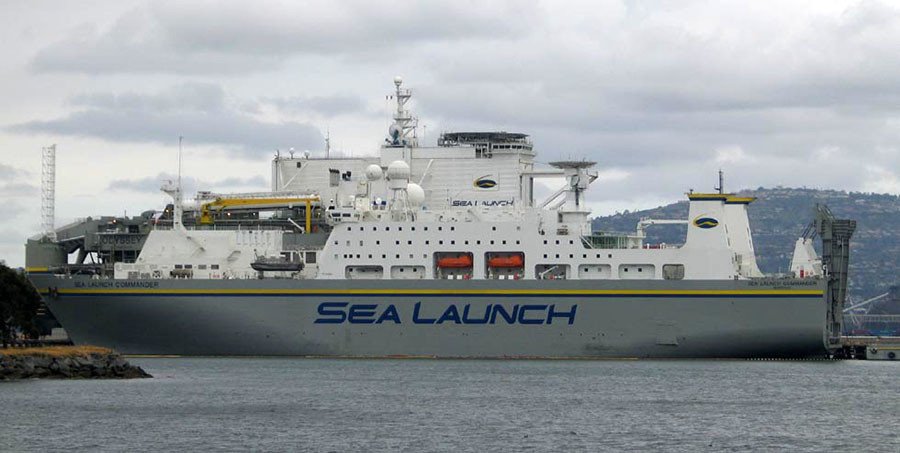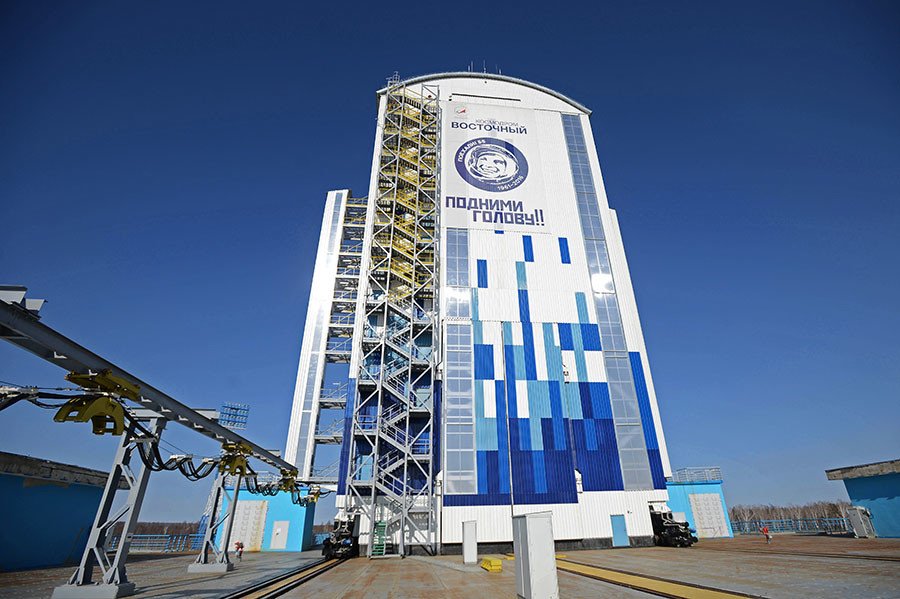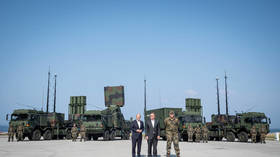Between a defunct satellite & nuclear space towboat: Russia feels its way to profiting in space

The revival of space launches from a sea platform serves as a pilot project for Russia's space agency's ability to benefit from private capital. Neglecting the commercial aspects of spaceflight is no longer an option.
Russian space agency Roscosmos has long ignored the arrival of private firms in the space industry, and the result has been the loss of international customers and sluggish development in new technology. But now Roscosmos is apparently willing to cooperate with for-profit organizations. As the world celebrates International Space Day on Thursday, RT looks at how the revival of the Sea Launch project attempts to become a proof-of-concept for a shift in how the Russian space industry works.
In late December 2017, a rocket was launched from the Baikonur Cosmodrome in Kazakhstan and delivered a telecommunications satellite into orbit. The Russia-made spacecraft was supposed to reach geosynchronous orbit and become the first operated by the African nation of Angola. Instead, it experienced communication glitches and was finally ordered by mission control to go into hibernation. AngoSat 1 may yet to be revived later this month, but there is not much hope for it.

Yet one party involved in the launch considered it a big success. The carrier rocket that delivered AngoSat 1 to its orbital grave was a Russian-Ukrainian Zenit-3F, a version of a rocket family developed by the Soviet Union and remarkable for its other version – the Zenit-3SL. The letters stand for 'Sea Launch' – an ambitious collaboration for launching commercial payloads from a sea platform floating near the equator. The December 2017 launch was the first for Sea Launch's new private owner, the S7 Space.
Every penny counts
Sea Launch started in 1995, capitalizing on an idea previously explored by Italy's Broglio Space Centre. Launching from the equator has several benefits compared to other locations, allowing heavier payloads to be lifted at lower cost per kilogram – good for placing communications satellites to a geostationary transfer orbit (GTS), the orbit from which the satellites reach their final geosynchronous destination.
Unlike the stationary off-shore Italian platform, Sea Launch has a floating platform and a separate assembly and command ship called the Sea Launch Commander – which was recently used as a filming location for the action film Captain America: The Winter Soldier. A rocket is assembled and fuelled on the ship while in port and transferred to a hangar on board a self-propelled platform called the Ocean Odyssey. Both then sail to a point in the Pacific, which could be perhaps be described as the middle of nowhere, and there the rocket is lifted into vertical position and launched while the command ship keeps a safe distance of about 5km.

The Sea Launch consortium initially included the US company Boeing as system integrator, Ukraine's duo Yuzhnoye/Yuzhmash, the producers of the Zenit rockets, Russia's Energia to provide the Block DM-SL third rocket stage, and Norway's Aker Solutions, which provided the sea craft for the project. Over 15 years it conducted 32 successful launches and one partially successful launch with three failures, weathered a Chapter 11 bankruptcy in the US and a financial battle between the owners, and finally suspended its operation in 2014.
S7 Space, a subsidiary of Russia's biggest airline, started acquiring Sea Launch in 2016 and plans to restart its orbital services in 2019. It received the AngoSat 1 mission as a legacy. The satellite was initially planned to be boosted from the Ocean Odyssey, experienced years of delays, got bounced to the backup launch site in Kazakhstan with a different version of the carrier rocket, and became S7's pilot attempt at space. A somewhat rocky start, all things considered.
Rockets from Ukraine
The revival of equatorial launches provides a few challenges for S7, including the supply of rockets. The launch pad stopped operating in 2014 because Zenit, technically a Ukrainian product, required close collaboration with Russia. After Kiev and Moscow started becoming antagonistic towards each other, cooperation with any hint of a military aspect was cut by the Ukrainian government. Uzhmash has since been struggling to find customers and overcome its dependence on parts from Russia, including engines, which comprise roughly 70 percent of the rocket.
Nevertheless, last June, Uzhmash announced it will produce 12 Zenit rockets for S7, with the Russian company scheduling the first new launch for 2019. The deal was apparently the result of a compromise between the US, Russia, and Ukraine. The Ukrainian producer will be assembling the rockets on US soil – where costly Russian parts will not be in danger of seizure by Kiev.
Roscosmos will also have to show goodwill for the project to go further. The agency is notoriously conservative and unwilling to acknowledge that Russia needs private capital to remain a prominent space nation, according to critics. This position has already cost Russia market share in launch services, which the ageing Progress rocket lost to younger and more capable competitors like Space X.
Bottom line boost
The Russian space agency has long enjoyed a secure position in Russia, being virtually the sole provider of access to orbit with a steady stream of government contracts. Space officials could simply reuse and slowly improve legacy technologies from Soviet times with little regard to how efficient the industry was. After all, that was how business was done in the glory days of the Buran/Energia project and that is how China is currently making steady progress in space. Failures and reliability problems were brushed aside as mere glitches. Clutter in the production pipeline was perceived as inevitable. The drive in the US to hand over non-strategic space missions to private companies was dismissed as nonsense.

In 2014, the defense & space deputy prime minister, Dmitry Rogozin, joked that if the Americans try to sanction the Russian space industry, they should be prepared to travel to the International Space Station with a trampoline. Amid the jokes and denials, Falcon 9 virtually kicked Protons from the international market of satellite launches, Falcon Heavy proved that a private company can fly a car towards Mars, and Dragon 2 is about to break Russia's temporary monopoly on manned space missions.
S7 becoming the Sea Launch operator seems to be Russia's biggest attempt to privatize the part of its space industry where such a move makes sense, making it more competitive in purely financial terms. Irritation over Roscosmos' bottom line has grown in the government for some time now, culminating last December in a rare public castigation by Andrey Belousov, a presidential aide. He blasted the industry's 220,000 employees and 90 organizations as "a mass of people who can't earn damn money."
Big Zenit plans
The politically perilous resurrection of Sea Launch has potential long-term consequences. S7 plans to switch in around 2022 from Zenit rockets to a new carrier called Soyuz-5, also dubbed Fenix after the code name of its development program. It's a major upgrade of the Zenit design currently in the works by Energia, and an apparent competitor to the Angara rocket family, which was developed by another Russian space contractor, the Khrunichev Center.

On its own, the Soyuz-5 is a designated replacement for the Proton-M and Zenit versions, but it will also serve as the basis for a new super heavy lift rocket, which was signed for development by Roscosmos last week. Russian President Vladimir Putin on Thursday announced that the maiden flight of the rocket, which is necessary for serious exploration of the moon and beyond, will happen in a decade. Some of the reported design elements of the super heavy Soyuz-5 are obviously inspired by Space X successes, like a reusable first stage or a modular composition of multiple-engine boosters for heavier versions, similar to Falcon Heavy.
According to open-source data, the final launch system includes a new launch pad, the carrier rocket, a new third stage, and possibly a transfer spacecraft with a nuclear propulsion system. The "space towboat" will deliver heavy payloads like supply cargo for a moon base or modules of a lunar orbital space station after they are launched from Earth.
These plans are still decades away from implementation, of course, and Russia has a lot of catching up to do. Roscosmos has other directions to reassert its position, like developing a two-stage Proton to cut cost to compete for lighter payloads, or making Angara's first stage reusable too. But interestingly, S7 has direct input on the development of S7, dictating on cost efficiency and other commercial considerations. It's a bitter pill for Roscosmos to swallow, but it has to.
Think your friends would be interested? Share this story!















